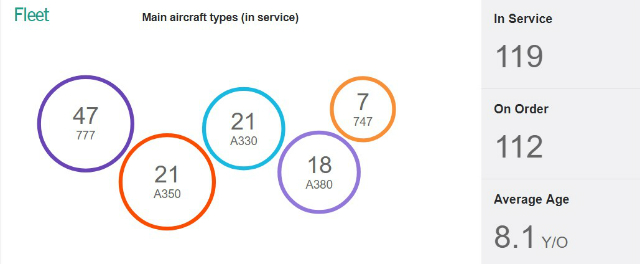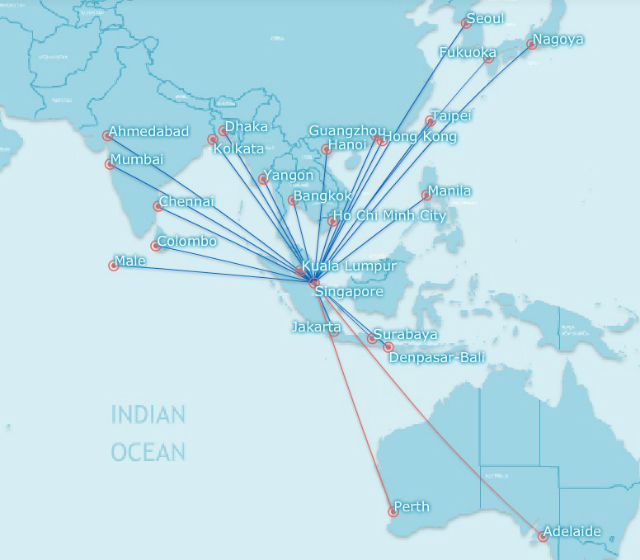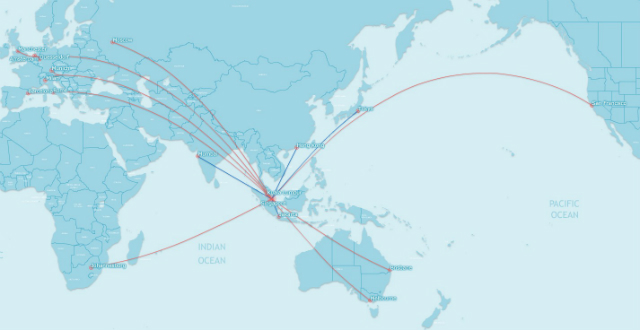Singapore Airlines’ fleet is evolving as it picks up the pace of delivery of new-generation aircraft.
SIA will take 20 new jets in 2018 – the highest number in the last five years. It has so far added four Boeing 787-10s, one A350-900 and one A380, and the rest of the year will see the addition of 10 A350s, two A380s and two 787s. Of the 10 incoming A350s, seven units will be the ULR variant, which will allow the carrier to fly further and in an all-premium configuration.

The next four years will see the Star Alliance carrier add a further 99 aircraft, including 20 777Xs it has on order that are due to be delivered from 2021 through to 2022. Deliveries will peak in 2021, with 43 incoming aircraft, Flight Fleets Analyzer shows.

SIA/Boeing
When all aircraft are delivered – and if it does not exercise any options – SIA will have 67 A350-900s, 49 787-10s (pictured above) and 20 777Xs. These, together with the A380s, would form the bulk of its fleet.
SIA has said that the 787-10 will eventually replace its A330-300s, of which 11 units are scheduled to be returned to lessors by 2020, Fleets Analyzer shows. The A350-900s, meanwhile, will replace the older 777s in future.
Singapore Airlines' fleet composition, June 2018

Flight Fleets Analyzer
787 TO GO REGIONAL
Chief executive Goh Choon Phong has said that the carrier will deploy the -10s, configured with 337 seats in two classes (36 in business, 301 in economy) on regional and medium-haul routes. FlightGlobal schedules data shows that as of last month it has already introduced the type on services from Singapore to Osaka Kansai and Perth.
To Osaka, the -10 has replaced the A330-300, while to Perth, the type is operating alongside the ageing 777-200ER and A330-300.
SIA's A330 network gives a sense of where the carrier likely plans to deploy the 787-10 going forward. The A330, SIA's primary regional aircraft today, has a range that encompasses Southeast Asia, North Asia, the Indian subcontinent and much of Australia – where Goh has declared there will be more 787-10 services.
"This aircraft is very suitable for some of the Australian operations," he said in March during the delivery of SIA's first -10. "There will probably be more routes in Australia where we'll consider deploying this aircraft.
SIA's A330 network, June 2018

FlightMaps Analytics
FlightGlobal schedules data shows that SIA still flies A330-300s to Perth and Adelaide. However, its services to Brisbane are served by A350-900s and 777-200ERs, while Sydney is served by A380-800s and 777-300ERs. Canberra is served by 777-300ERs, while Melbourne is served by almost all its widebodies: A350-900s, A380-800s, 777-200ER and -300ERs.
SIA PLAYS PREMIUM GAME WITH A350
At the same time, SIA is tapping on the range and fuel efficiency of the A350 for network growth opportunities.
At the Singapore air show in February, Goh said the A350 has made possible routes that were previously commercially unviable. This has led to the launch of services to Dusseldorf (July 2016) and Stockholm (May 2017), as well as planned ultra-long-range services to New York and Los Angeles.
SIA's A350 network, June 2018

FlightMaps Analytics
The carrier will launch the world’s longest commercial flight on 11 October, with its near-19 hour nonstop Singapore-Newark service. Details of its planned Los Angeles service will be announced later.
SIA suspended nonstop services to Newark and Los Angeles in 2013, amid high fuel costs and weak corporate demand. Then, it was using fuel-thirsty A340s, fitted with 181 seats: 64 in business and 117 in “executive economy".
The airline is now evaluating other possible destinations it can fly with the ULRs, Goh told reporters this week: “I'm looking at where else to fly… seven aircraft is probably more than what's needed for the New York and LA routes. There are ways we can structure our US operations and we will announce them."
Shukor Yusof, founder of aviation advisory firm Endau Analytics, points to Chicago, Atlanta and Boston as destinations that are popular for both corporate and leisure travel, and where SIA can possibly deploy the A350ULR.
The launch of more ultra-long-haul services would dovetail with SIA’s three-year transformation programme. SIA has earmarked the premium market as a key growth avenue, and says that it would strengthen its premium positioning.
Goh is also optimistic on its plans for the ultra-long-haul segment, despite rising oil prices: “We are getting these planes [the A350-900ULR] because they are the most advanced fuel-efficient planes and we are reasonably hedged for the next four to five years. I don’t think [oil prices] are an immediate concern for now."
SIA has also said that it will place its new 777Xs that will be delivered from 2021 for long-haul expansion, operating alongside the A350-900.
RIVAL QANTAS LURKING WITH ULR PLANS
"Oil hitting the $100 per barrel mark may happen, but not so soon. SIA already has the latest-generation aircraft – they are confident on building demand on such routes, and the USA represents the next 'frontier' of network growth from Singapore or Southeast Asia and even Australia," says Shukor.
Fellow Asia-Pacific rival Qantas, for one, has said that it would issue a request for proposals on a new ultra-long-haul aircraft next year. The Australian carrier wants an aircraft that would allow it to launch nonstop flights from Sydney and Melbourne to London and New York around 2022. Group chief executive Alan Joyce has also nominated Chicago, as well as points in Brazil and European cities as later possibilities.
Shukor says that although Qantas could hit the same points as SIA, its ultra-long-haul target segment is that of the wider travelling public, instead of a premium focus. Moreover, Qantas will be able to leverage its multiple hubs across Australia (Sydney, Melbourne, Brisbane, Adelaide and Perth) to generate demand for these ultra-long-haul routes.
Building market dominance on its ultra-long-haul routes will be high on SIA's agenda in the coming years.
"SIA is one of the very few airlines in the world that can afford to launch ultra-long-haul flights. They are cash rich and have built up a strong financial profile, which allows them to acquire the latest new-generation aircraft and means they can better withstand losses," says Shukor.
"This new makeover [of the SIA Group] has seen them pass on the short-haul and other regional and long-haul services to [low-cost unit] Scoot, which themselves are doing very well and cater to a different market segment. Going long-haul and ultra-long-haul with a premium product clearly means that SIA is focusing on the high net worth segment of travellers."
Source: Cirium Dashboard


























